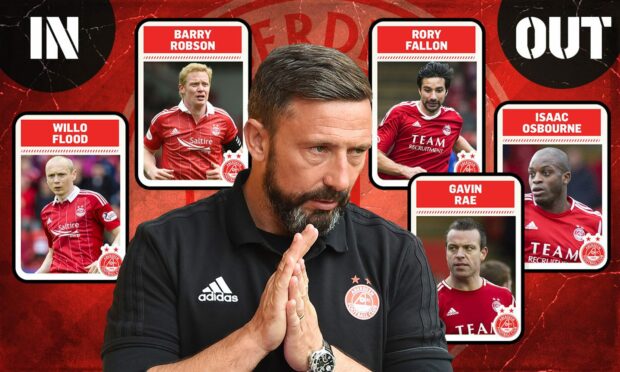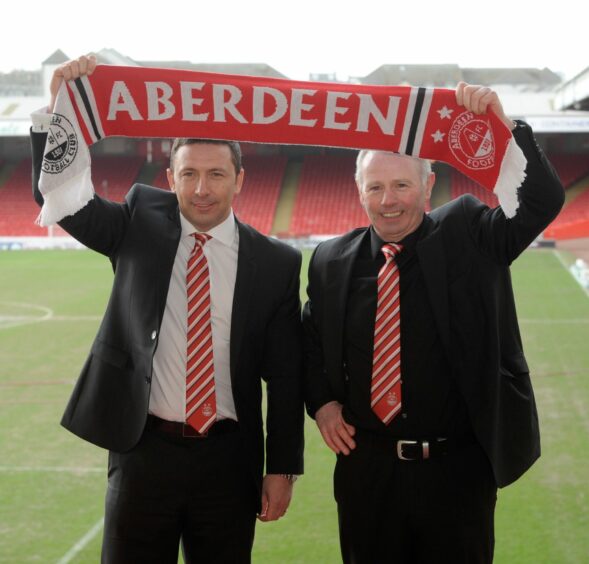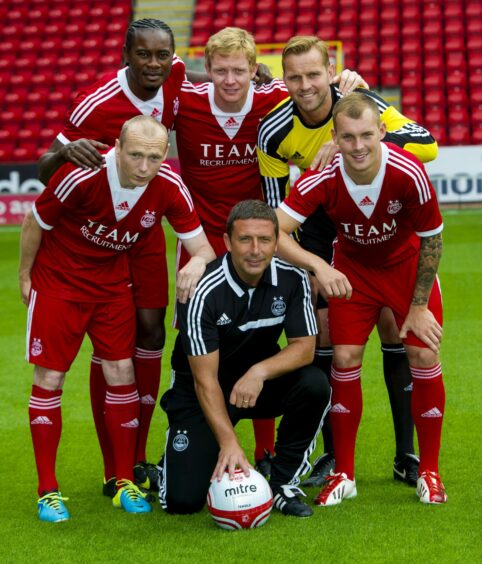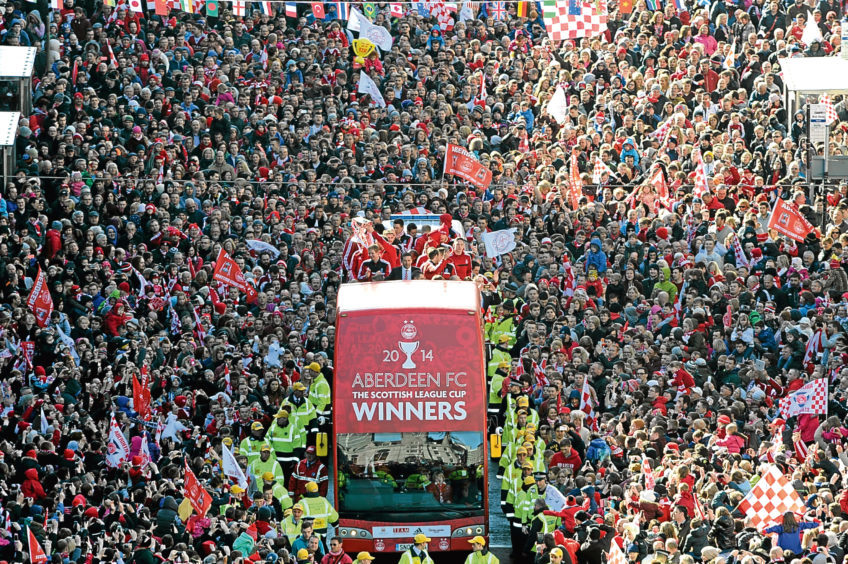Former Aberdeen boss Craig Brown left some solid foundations when he retired to join the Dons board in 2013.
But it was the introduction of two midfield enforcers which helped provide the steel his replacement Derek McInnes was looking for.
McInnes was a man with a point to prove after returning to Scottish football following a disappointing spell in England with Bristol City.
Having built his managerial reputation with St Johnstone where he led the club to promotion in 2009, McInnes lasted 16 months with City before being dismissed following a run of one win in his last five matches in January 2013.
He was in the frame for the Dundee United job but it was former Dons chairman Stewart Milne who offered his route back into the game at Pittodrie three months later.
Less than 12 months later that decision had been repaid with the club’s first silverware in 19 years, the League Cup.
Tannadice tussle convinced McInnes to move for Flood
McInnes used the final five games of the 2012-13 season to run the rule over his squad and only one player nearing the end of his contract – striker Josh Magennis – was offered a new deal.
That meant Rory Fallon, Mitch Megginson, Rob Milsom, Gary Naysmith, Isaac Osbourne, Gavin Rae and Dan Twardzik were all freed while Stephen Hughes and Jordon Brown were told they were free to find new clubs.
McInnes had used the days prior to taking over from Brown wisely, however, watching his predecessor come up just short in the final game before the split against Dundee United at Tannadice.
The home side won 1-0 to pip the Dons top the top six in Brown’s final game in charge.
But it was the performance of United captain Willo Flood which stood out for Brown’s incoming replacement.
McInnes wants that drive and energy in his team and he promptly went out and got it, convincing Flood to swap Tannadice for Pittodrie for the 2013-14 campaign.
McInnes said: “I watched him in the game against Aberdeen before the split and he was tremendous.
“He got up and down the park and he provided the team with great drive and energy.
“That’s what he will bring to Aberdeen. Willo’s a great character as well. He’s a real winner and he demands a lot of himself and of the people around him.
“He’s the kind of player that lifts everyone in the team and he can make things happen.
“It’s not just the energy though because Willo is capable of getting his foot on the ball and getting the passing game going and that is going to be important to the way we want to play.
“We want to play at a high tempo and get the ball moving quickly and that is very much Willo’s game.”
Robson was Flood’s partner in crime in Pittodrie midfield
If Flood was the grit then his new midfield partner Barry Robson was the guile – not that Robson lacked any grit of his own to be fair.
Robson was the old head in the Aberdeen engine room alongside Flood.
A former winger at Caley Thistle turned central midfielder while at Celtic, his arrival from Sheffield United gave McInnes a seismic shift in terms of how his team would play.
McInnes said: “Barry has tons of experience.
“There’s a lot of young players in the team and that experience is going to be vital.
“Barry ticks so many boxes. He’s 34 but he is in terrific shape, there’s not an ounce of fat on him and he has steered clear of any major injuries.
“He’s a local lad and he really wants to play for Aberdeen.
“With the great career he has had he could quite easily put the feet up but he’s still got as much hunger and desire as ever.
“Barry wants to come to Aberdeen to make a real impact. He’s a leader and a winner on and off the pitch and he will be able to play in a number of positions.
“There won’t be many better than him in the SPL when it comes to set pieces as well.
“His delivery is exceptional and that is another area of the team we want to work on to make us a threat from set plays.
“It’s a great deal financially for the club as well so when you add it all together it represents a great bit of business.”
Others followed with Calvin Zola, Gregg Wylde, Lawrence Shankland, Nicky Weaver and loan player Michael Hector all joining that summer but it was the two central midfielders who made the biggest impression.
December arrivals helped turn Dons into cup winners
Robson and Flood’s arrival gave McInnes a solid spine throughout his team.
With Jamie Langfield in goal and Russell Anderson and Mark Reynolds in front of him, the addition of Robson and Flood was key.
The decision to move Niall McGinn, the leading scorer from the previous season, out wide on one wing with Jonny Hayes rampaging down the other made the Dons a formidable outfit.
But it was not until the January window that the Dons boss found the missing pieces to turn his side from challengers into cup winners with the signings of Adam Rooney and Shay Logan.
Former Caley Thistle striker Rooney was a goal machine, pure and simple. Six goals in his first eight games and the winning penalty in the shootout against Inverness in the League Cup final made him an instant hero.
It is a measure of how much progress the team made in a year that finishing third in the league and reaching the semi-final of the Scottish Cup felt as if opportunities had been missed.
- What did other Aberdeen managers do in their first transfer window? Read more here:
New recruits were key in Jimmy Calderwood hauling Aberdeen up the table
Revisiting a struggling start for Aberdeen boss Mark McGhee in 2009
Plugging the gaps was Craig Brown’s first challenge at Aberdeen
Stephen Glass’ red revolution petered out after a promising start



